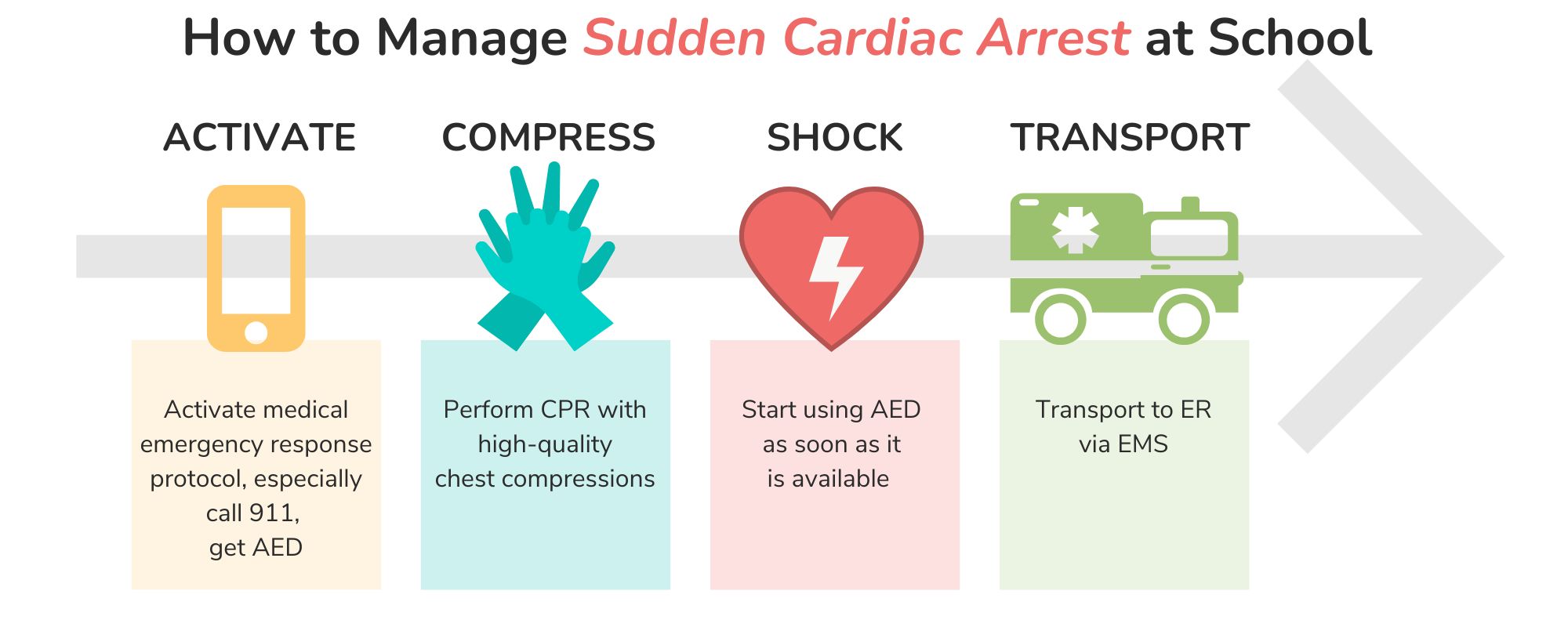Cardiac Emergencies
Even "healthy" kids can have sudden cardiac arrest
Cardiac Emergencies
Cardiac emergencies, specifically sudden cardiac arrest (SCA), occur at schools of all ages and demographics across the country.
SCA occurs when the heart stops beating effectively, leading to a loss of circulation and consciousness, and resulting in no blood flow to the brain and other vital organs. Some abnormal heart rhythms can result in SCA. While these life-threatening rhythms are not common, such conditions often go undetected until a life-threatening event occurs.
The best chance of saving a life during a SCA is by using an automated external defibrillator (AED) within the first THREE minutes of the emergency.
Not all states require that AEDs be present in schools despite AEDs being easy to obtain and relatively low in cost, especially given how effective they are when used promptly during SCA. Many physicians strongly recommended that all schools have at least one AED on campus for use during SCA. When SCA is immediately recognized and the AED is used promptly, individuals are more likely to experience good outcomes.
Schools need to be always ready to recognize and respond to SCA. Part of a school’s medical emergency response planning needs to include education on this medical emergency. Keep reading for key points on how you can recognize and respond to SCA.

Recognize
How to identify sudden cardiac arrest:
SCA manifests as loss of consciousness and absent or abnormal breathing. SCA can happen at any time with some heart rhythm disorders being more likely to manifest as SCA during exercise.

Loss of Consciousness

Absent or Abnormal Breathing
Risk Factors
Fainting, especially in the midst of exertion.
A dangerous heart rhythm can cause an ineffective heartbeat, which then halts blood flow to the brain. When the brain does not receive blood, the person loses consciousness and may die if the abnormal rhythm is not immediately addressed. AEDs recognize abnormal heart rhythms and provide shocks to normalize the rhythm, which then allows the heart to beat effectively.
Family History
A history of the following conditions means someone is at a higher risk of SCA:
- Sudden cardiac arrest, particularly before the age of 50 years-old
- Specific, inheritable heart rhythm disorder
- Sudden infant death syndrome
Respond
When you see a cardiac emergency, follow this protocol:

Activate your medical emergency response protocol including calling 911 immediately and fetching the AED immediately.

Start CPR immediately by performing high-quality chest compressions.

Use the AED as soon as it arrives - time to shock is critical for survival!

Perform any additional treatment as directed by the 911 operator until EMS arrives, at which time the person will go to the emergency department for further care.
Recommended School-Focused Cardiac Emergency Education
Click on the logos below to learn more about each program.
For your school to be prepared for any medical emergency, you need a plan and team. Med-E Ready guides you through creating exactly that.
The American Heart Association partners with educators in elementary, middle and high schools across the nation to help educate students about healthy living.
Project ADAM’s mission is to save lives by empowering schools and communities to be prepared for a sudden cardiac arrest.
The Sudden Cardiac Arrest Foundation’s vision is to eliminate preventable death and disability from sudden cardiac arrest and support people affected by SCA.
Get Prepared For All Emergencies
Feel equipped for this emergency? Take the steps to get prepared for another one.






